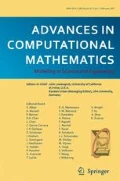Abstract
Systems of implicit delay differential equations, including state-dependent problems, neutral and differential-algebraic equations, singularly perturbed problems, and small or vanishing delays are considered. The numerical integration of such problems is very sensitive to jump discontinuities in the solution or in its derivatives (so-called breaking points). In this article we discuss a new strategy – peculiar to implicit schemes – that allows codes to detect automatically and then to compute very accurately those breaking points which have to be inserted into the mesh to guarantee the required accuracy. In particular for state-dependent delays, where breaking points are not known in advance, this treatment leads to a significant improvement in accuracy. As a theoretical result we obtain a general convergence theorem which was missing in the literature (see Bellen and Zennaro, Numerical Methods for Delay Differential Equations, Oxford University Press, Oxford, 2003). Furthermore, as a useful by-product, we design strategies that are able to detect points of non-uniqueness or non-existence of the solution so that the code can terminate when such a situation occurs. A new version of the code RADAR5 together with drivers for some real-life problems is available on the homepages of the authors.
Similar content being viewed by others
References
Bellman, R., Cooke, K.L.: Differential-Difference Equations. Academic, New York (1963)
Baker, C.T.H., Paul, C.A.H., Willé, D.R.: Issues in the numerical solution of evolutionary delay differential equations. Adv. Comput. Math. 3, 171–196 (1995)
Brunner, H.: Collocation Methods for Volterra Integral and Related Functional Differential Equations. Cambridge University Press, Cambridge (2005)
Butcher, J.C.: The adaptation of stride to delay differential equations. Appl. Numer. Math. 9, 415–425 (1992)
Bellen, A., Zennaro, M.: Numerical Methods for Delay Differential Equations. Oxford University Press, Oxford (2003)
Castleton, R., Grimm, L.: A first order method for differential equations of neutral type. Math. Comp. 27, 571–577 (1973)
Enright, W.H., Hayashi, H.: A delay differential equation solver based on a continuous Runge-Kutta method with defect control. Numer. Algorithms 16, 349–364 (1997)
Enright, W.H., Hayashi, H.: The evaluation of numerical software for delay differential equations. In: The Quality of Numerical Software: Assessment and Enhancements, pp. 179–192. Chapman and Hall, London (1997)
El’sgol’ts, L.E., Norkin, S.B.: Introduction to the Theory and Application of Differential Equations with Deviating Arguments. Academic, New York(1973)
Feldstein, A., Neves, K.W.: High order methods for state-dependent delay differential equations with nonsmooth solutions. SIAM J. Numer. Anal. 21, 844–863 (1984)
Guglielmi, N., Hairer, E.: Implementing Radau-IIA methods for stiff delay differential equations. Computing 67, 1–12 (2001)
Hauber, R.: Numerical treatment of retarded differential-algebraic equations by collocation methods. Adv. Comput. Math. 7, 573–592 (1997)
Hairer, E., Nørsett, S.P., Wanner, G.: Solving ordinary differential equations I. Nonstiff Problems. In: Springer Series in Computational Mathematics, 2nd edition, vol. 8. Springer-Verlag, Berlin (1993)
Hairer, E., Wanner, G.: Solving ordinary differential equations II. Stiff and Differential-Algebraic Problems. In: Springer Series in Computational Mathematics, 2nd edition, vol. 14. Springer-Verlag, Berlin (1996)
Jackiewicz, Z., Lo, E.: The numerical solution of neutral functional differential equations by adams predictor-corrector methods. Appl. Numer. Math. 8, 477–491 (1991)
Kuang, Y.: On neutral delay logistic Gause-type predator-prey systems. Dynam. Stability Systems 6(2), 173–189 (1991)
Paul, C.A.H.: A Test Set of Functional Differential Equations. Numerical Analysis Report 243, University Manchester (1994)
Waltman, P.: A threshold model of antigen-stimulated antibody production. In: Theoretical immunology. Immunology Ser., vol. 8, pp. 437–453. Dekker, New York (1978)
Willé, D.R., Baker, C.T.H.: The tracking of derivative discontinuities in systems of delay differential equations. Appl. Numer. Math. 9, 209–222 (1992)
Author information
Authors and Affiliations
Corresponding author
Additional information
Communicated by A. Iserles.
Supported by the Italian M.I.U.R. and G.N.C.S.
Supported by the Swiss National Science Foundation, project # 200020-101647.
Rights and permissions
About this article
Cite this article
Guglielmi, N., Hairer, E. Computing breaking points in implicit delay differential equations. Adv Comput Math 29, 229–247 (2008). https://doi.org/10.1007/s10444-007-9044-5
Received:
Accepted:
Published:
Issue Date:
DOI: https://doi.org/10.1007/s10444-007-9044-5
Keywords
- Implicit delay differential equations
- Runge–Kutta methods
- Radau IIA methods
- Breaking points
- Non-existence and non-uniqueness of solutions
- Error control
- Numerical well-posedness


